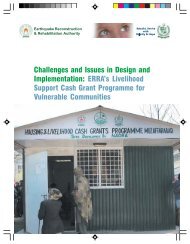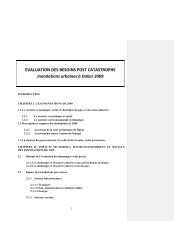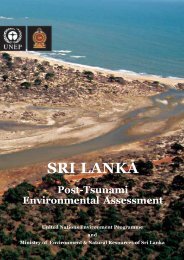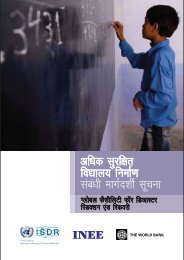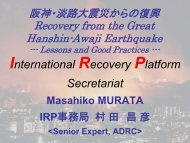The Maldives
The Maldives
The Maldives
You also want an ePaper? Increase the reach of your titles
YUMPU automatically turns print PDFs into web optimized ePapers that Google loves.
<strong>The</strong> first few days<br />
<strong>The</strong> National Security Service (NSS) immediately launched a series of<br />
search and rescue, and logistics missions, and within two to three days the<br />
Coast Guard had visited all of the inhabited islands and set up forward<br />
coordinating centres for a cluster of atolls. From the first day, an important<br />
concern was to re-establish communication with atolls. <strong>The</strong> Coast Guard,<br />
along with local fishermen, and commercial vessels, used high frequency<br />
radios to relay information back to the coordination centre in Malé from<br />
the most severely affected regions until telecommunications could be<br />
re-established. <strong>The</strong> NSS played a key role in providing early relief, while<br />
other militaries in the vicinity generously lent their support and were<br />
tasked with a variety of missions.<br />
Several foreign navies arrived in the <strong>Maldives</strong> to provide assistance,<br />
bringing with them much needed food supplies. <strong>The</strong> Pakistan Armed<br />
Forces picked up tourists from the affected resorts and transferred them<br />
to unaffected ones or to the international airport. <strong>The</strong> Bangladesh Armed<br />
Forces helped with initial clean-up efforts and with medical evacuations.<br />
<strong>The</strong> French Navy also conducted medical evacuations, and assisted with<br />
food distribution, and the repair of generators. <strong>The</strong> Indian Armed Forces<br />
used their helicopters and ships to reach islands with narrow harbours,<br />
or where harbours had completely collapsed, to help load and unload<br />
equipment.<br />
Much needed water was brought to the islands by US naval ships.<br />
Both the IFRC and the British Government made additional landing<br />
barges available to assist in delivering relief material, including 32<br />
generators and construction materials, to isolated islands. <strong>The</strong> National<br />
Disaster Management Centre (NDMC) coordinated all foreign military<br />
vessels and aircraft to ensure the smooth running of the military assistance<br />
during the relief effort. <strong>The</strong> various militaries stayed for up to two months<br />
to help the <strong>Maldives</strong> get over the initial humanitarian crisis, during which<br />
time the NSS also began to help build the first temporary shelters.<br />
Emergency Food Aid<br />
Delivery of food to affected islands was one of the most pressing<br />
concerns in the first days following the tsunami. Not surprisingly,<br />
the most immediate response to the need came from the people<br />
themselves, with residents of Malé and other less affected islands<br />
buying food and sending it to other islands at their own initiative.<br />
This action was mirrored on a national scale by the Government,<br />
which sent rice, sugar, and flour to the affected islands. Over the<br />
next days and weeks, emergency food relief arrived from numerous<br />
sources and was distributed either at the expense of the donors or<br />
through the Government transportation system.<br />
A large part of the food requirements was later covered by the UN,<br />
specifically United Nations Children’s Fund (UNICEF) and the<br />
World Food Programme (WFP). <strong>The</strong> Ministry of Education and WFP<br />
launched an emergency school feeding project for the first term of the<br />
school year, targeting 25,000 children on 79 islands. In February, WFP<br />
and the Government launched a targeted feeding programme covering<br />
some 41,000 people on 91 islands. In addition, the Government<br />
continued to provide vegetables, fish, and condiments, and UNICEF<br />
provided baby food to 6,800 children under five on the same islands.<br />
<strong>The</strong> joint WFP-Government programme has continued throughout 2005,<br />
with the number of targeted people dropping to some 13,000 including<br />
IDPs and their host families. This number will reduce further as more<br />
IDPs move back into their homes.<br />
Another notable feature of the immediate aftermath of the tsunami<br />
was the response of various communities and private sector companies,<br />
many of whom independently took in displaced families and distributed<br />
essential provisions. Even before any organised relief effort began,<br />
concerned citizens took the initiative to collect food, water, and clothing<br />
and used their undamaged boats and planes to distribute assistance to<br />
those in need. <strong>The</strong> local radio and TV stations, Voice of <strong>Maldives</strong> and<br />
Television <strong>Maldives</strong>, made appeals for aid, and local boat and plane<br />
companies provided their services at no charge in the effort to reach the<br />
affected islands. This prompt action was instrumental in ensuring that<br />
communities were able to cope even before government and international<br />
relief could reach the geographically dispersed islands.<br />
10 | THE MALDIVES ONE YEAR AFTER THE TSUNAMI


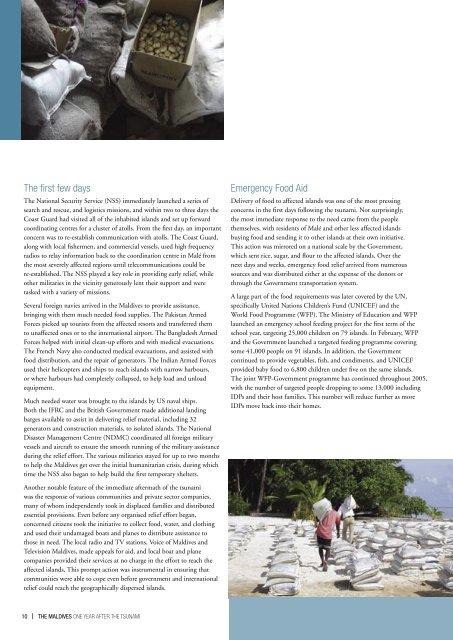



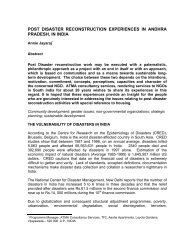
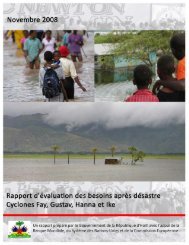
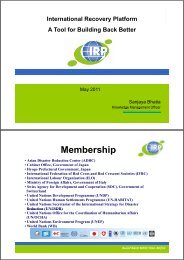
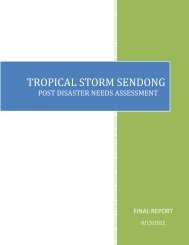
![View full document [PDF 7.65 MB] - unisdr](https://img.yumpu.com/48902806/1/178x260/view-full-document-pdf-765-mb-unisdr.jpg?quality=85)
